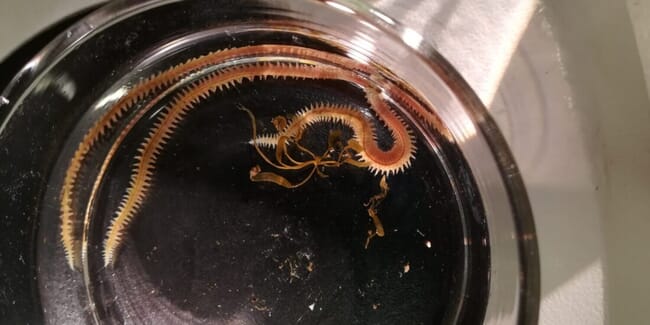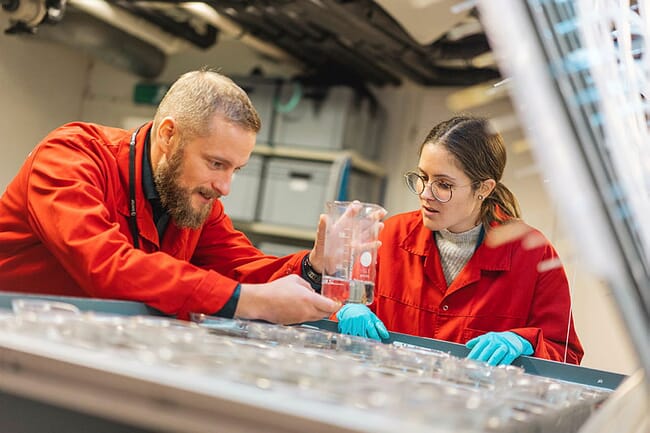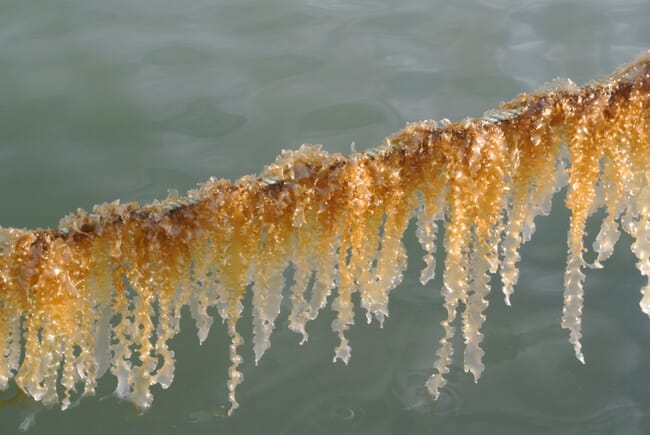
This little creature can help the salmon farming sector address a major challenge by providing locally-sourced and sustainable food for the fish © Haiqing Wang, SINTEF
Norwegian researchers pitched an offbeat idea – feeding ragworms with locally-cultivated seaweeds. The results were as gold-edged as the worms themselves – a high-quality, locally-sourced and sustainable feed for farmed salmon.
“Ragworms are an exciting new feed raw material that can help to reduce the sector’s dependency on imported materials, thus making Norwegian salmon a more eco-friendly and sustainable product,” says SINTEF researcher Andreas Hagemann.
Seaweeds are also a major resource, and in recent years many companies have been established along the Norwegian coast to cultivate them. Researchers have now demonstrated that seaweeds are ideal as feed for ragworms, which in turn can be transformed into a high-quality feed for farmed salmon.
Demand for more sustainable feed alternatives
The seaweed-ragworm combination may also help to resolve a major problem. The salmon farming and feed sectors are crying out for new and sustainable raw materials. It is vital that they become less dependent on soya protein and other less environmentally sound raw materials that have to be transported for long distances in order to supply Norwegian fish farms.
“Seaweeds have high levels of carbohydrates but contain too little fat and so cannot be fed directly to farmed salmon”, says Hagemann. “However, by first feeding the seaweeds to ragworms, we obtain a high-quality feed that is rich in Omega-3, and with the right composition of other fatty acids and marine proteins. This is also a good way of exploiting residual raw materials derived from seaweed production,” he says. The research is being carried out as part of a project called POLYKELP, which is being coordinated by SINTEF Ocean.
The key idea
Even though seaweeds are not suitable to be fed directly to salmon, they have many valuable properties that open the door to multiple uses. Seaweeds for human consumption are usually harvested in the spring. As the plants grow larger during the summer months, they often become fouled, which makes them look and taste less appealing as food for humans.
However, the plants are at their biggest during the summer months, so the farmers can harvest greater volumes. Moreover, seaweed off-cuts can be used as food. So, there is no shortage of seaweed raw material available that can be used for a wide variety of useful applications.

Seaweeds are a very useful raw material. Large-scale cultivation can remove CO2 from the atmosphere, and they can be used both as food and as a soil improver in agriculture. They can also play an important role as a sustainable raw material for the local sourcing of feed for farmed salmon © Ingar Storfjell
It was this that led to the initial idea of first feeding seaweed to the ragworms, and then feeding the worms to the salmon.
Omnivorous ragworms?
Even though ragworms (Hediste diversicolor) are essentially omnivorous, the researchers were very interested to see how they would take to being fed seaweed.
“They eat pretty much anything, but this was the first time we had tried to feed them with a purely plant-based material”, says Hagemann. “Part of our aim was also to see if the ragworms can survive on seaweed alone, and to find out how it influences their growth rates and nutrient values,” he says.
They noted that seaweed contains too little fat to be used as salmon feed, but becomes ideal when it is refined or bioconverted by the additional step of being eaten by the ragworms.
“Our results show that the seaweed provides the ragworms with an excellent variety of fatty acids and that the feed quality of the worms is greatly enhanced by being fed with the fat-poor raw material,” says Hagemann.
Taking inspiration from silage bales
“Since the seaweed season is so short, it’s important to preserve the plants after they’ve been harvested,” says Hagemann. “Acid preservation, which is the method used when we store silage in bales, is a simple and inexpensive approach that works just as well for seaweed. For this reason, our aim was to compare feeding the worms with seaweed stored in this way with plants that had been kept in frozen storage and subsequently defrosted,” says Hagemann.
So, the researchers served both acid preserved and frozen seaweed to the ragworms every day for almost two months.
“The ragworms fed well on both types and the preservation methods had no effect on the subsequent nutrient value of the worms in terms of their fatty acid content,” says Hagemann.

Senior Research Scientist Andreas Hagemann and PhD student Andrea Rodriguez are studying a ragworm following an experiment © SINTEF
Optimising the ragworm diet
These experiments should be seen as just the start of a longer process. The researchers are not yet sure as to whether seaweed is an ideal feed for the ragworms on its own, but they have obtained positive results and are now working to optimise the ragworm diet.
“In the future we will be looking into how the seaweeds can be processed to make them an even better food for the ragworms,” says Hagemann. “We will also see whether the worms’ nutrient profile can be enhanced, perhaps by combining the seaweed with other types of residual raw materials,” he says.
A major local resource
“These excellent test results are very good news,” says SINTEF researcher Jorunn Skjermo, who is keen to point out that access to cultivated seaweeds is virtually unlimited.

Seaweed cultivation is a growing sector, and there are currently about 20 companies farming seaweeds in Norway
“Since seaweeds are being cultivated in floating marine facilities all along the coast of Norway, there are no limits to the availability of this raw material as is the case for naturally-occurring seaweeds,” says Skjermo. Such facilities can be located in areas without much other activity, provided that the space made available for the infrastructure is large enough to meet production requirements,” she says.
Seaweed cultivation is a growing sector, and there are currently about 20 companies farming seaweeds in Norway. Globally, it is a gigantic industry, producing more than 300 million tonnes each year.
“In Norway, we have the natural prerequisites in place for the production of both seaweeds and ragworms,” says Skjermo. “Since seaweed farming is seen as a sustainable method of raw materials production, a lot is happening in the sector right now, both in Norway and overseas. The sector is enjoying growth, and interest is increasing. More material is being produced locally and multiple uses are being identified,” she says.




